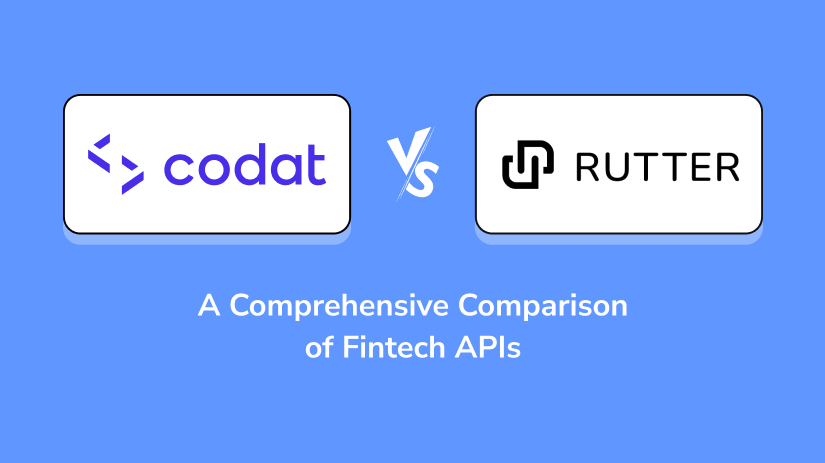In the rapidly evolving landscape of financial technology (fintech), the ability to seamlessly integrate data from various sources is paramount.
This is where fintech APIs (Application Programming Interfaces) come into play, enabling developers to access and utilize financial data efficiently.
Among the many players in this field, Codat and Rutter stand out as leading providers of fintech API solutions.
In this blog, we’ll conduct a detailed comparison of Codat vs Rutter, examining key features, functionalities, and use cases to help you determine which one best suits your needs.
Let’s Start!
Connect with us for Fintech Development Needs
Trusted by companies like Plaid, Yodlee, Codat.
Introduction to Codat and Rutter
Codat vs Rutter both offer APIs designed to facilitate the exchange of financial data between businesses and their partners, such as banks, accounting platforms, and other fintech applications. While their ultimate goal is the same, their approaches and features may vary significantly.
Codat
Codat positions itself as a universal API for financial data, aiming to simplify the process of accessing and using financial data across various platforms. It provides a single integration point for accessing data from multiple sources, including accounting software, banking platforms, and payment processors.
Codat’s API supports a wide range of data types, including transactional data, balance sheets, income statements, and more.
Rutter
Rutter, on the other hand, specializes in real-time financial data integration, focusing on streamlining the flow of transaction data between businesses and financial institutions.
Its API is optimized for speed and reliability, enabling businesses to access up-to-date financial data seamlessly. Rutter’s key features include support for bank feeds, transaction categorization, and reconciliation.
Feature Comparison of Codat vs Rutter
Now, let’s delve deeper into the features offered by Codat and Rutter to better understand their capabilities and limitations.

Data Sources
Codat
Supports integration with a wide range of data sources, including major accounting platforms like QuickBooks, Xero, and Sage, as well as banking institutions and payment processors.
Rutter
Primarily focuses on bank feeds and transaction data, offering seamless integration with banks and financial institutions.
Data Types
Codat
Provides access to a comprehensive set of financial data types, including transactional data, balance sheets, income statements, customer information, and more.
Rutter
Specializes in transaction data, offering features such as transaction categorization, enrichment, and reconciliation.
Integration Flexibility
Codat
Codat Integration Services offers a flexible and customizable integration framework, allowing developers to tailor the API to their specific needs and requirements.
Rutter
Rutter Integration Services, prioritizes simplicity and ease of integration, with a focus on real-time data streaming and minimal setup overhead.
Use Cases of Rutter vs Codat
Codat
Ideal for businesses looking to aggregate and analyze financial data from multiple sources, such as accounting platforms, banking institutions, and payment processors.
Rutter
Suited for businesses that require real-time access to transaction data for purposes such as fraud detection, financial reporting, and cash flow management.
Connect with us for Fintech Development Needs
Trusted by companies like Plaid, Yodlee, Codat.
Considerations for Choosing the Right API Between Codat vs Rutter
When evaluating Codat vs Rutter for your fintech integration needs, there are several factors to consider:
Data Requirements
Assess the specific types of financial data you need to access and whether the API supports those data types.
Integration Complexity
Consider the level of customization and flexibility required for your integration project, as well as the ease of setup and maintenance.
Real-Time Needs
Determine whether real-time data access and streaming capabilities are essential for your use case, and choose accordingly.
Scalability
Evaluate the scalability and performance of the API, particularly if you anticipate significant growth in data volume or user traffic.
Conclusion
In conclusion, under the financial IT services, both Codat and Rutter offer powerful fintech API solutions designed to streamline the integration of financial data for businesses.
Codat excels in its ability to aggregate data from diverse sources and support a wide range of data types, making it suitable for comprehensive financial data analysis.
On the other hand, Rutter specializes in real-time transaction data integration, catering to businesses with immediate data access needs.
Ultimately, the choice between Codat and Rutter will depend on your specific use case, data requirements, and integration preferences.
By carefully evaluating the features and capabilities of each API, you can select the solution that best aligns with your business objectives and technical requirements.
Happy Rutter & Codat Integration!!
Connect with us for Fintech Development Needs
Trusted by companies like Plaid, Yodlee, Codat.





